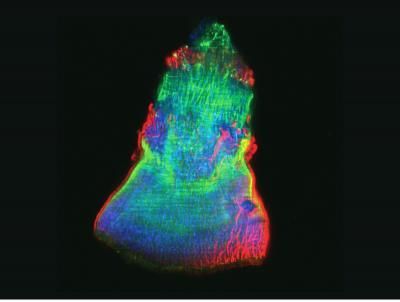Stem cells stand up for themselves
Adult stem cells are not pampered pushovers. O'Reilly et al. report that certain stem cells take charge of their surroundings, molding their environment to control their division and differentiation. Some stem cells are cosseted like newborns. Neighboring cells cradle them in a structure called the niche. The niche not only nurtures its charges, it also dictates their behavior, determining whether they reproduce and specialize. The standard view is that the niche shapes stem cells, not vice versa.
O'Reilly et al. found evidence for more active stem cells while studying how the cells anchor themselves in the Drosophila ovary. Previous work indicated that ovary stem cells attach to the niche through the protein E-cadherin. O'Reilly et al. tested whether the stem cells also depend on integrins, cell surface proteins that link molecules in the extracellular matrix to the cytoskeleton. They found that follicle stem cells (FSC) — one type of ovary stem cell — drifted away from their niche when they carried mutant integrins.
These breakaway cells were abnormally shaped, divided more slowly than normal, and displayed some cancer-like characteristics, such as refusing to stop crawling even after contacting another cell.
Integrins hook onto an extracellular matrix protein called laminin A. FSCs pump out laminin A, and the scientists found that mutant cells that were unable to make the protein broke their moorings and reproduced sluggishly. Two other kinds of stem cells in the ovary — germline stem cells, which spawn the egg, and escort stem cells, which travel along with it — didn't rely on integrins for anchoring, the researchers showed. The team concluded that the interaction between laminin A and integrins ensures that FSCs remain in place, primed to divide. By laying down laminin A, therefore, FSCs help build their own niche.
Original publication: O'Reilly, A.M., et al.; J. Cell Biol. 2008.
Organizations
Other news from the department science

Get the life science industry in your inbox
By submitting this form you agree that LUMITOS AG will send you the newsletter(s) selected above by email. Your data will not be passed on to third parties. Your data will be stored and processed in accordance with our data protection regulations. LUMITOS may contact you by email for the purpose of advertising or market and opinion surveys. You can revoke your consent at any time without giving reasons to LUMITOS AG, Ernst-Augustin-Str. 2, 12489 Berlin, Germany or by e-mail at revoke@lumitos.com with effect for the future. In addition, each email contains a link to unsubscribe from the corresponding newsletter.





















































